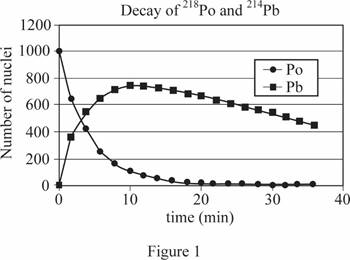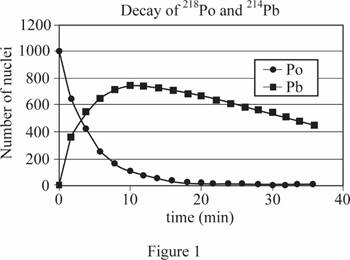
Concept explainers
(a)
The differential equation that defines the number of daughter nucleus.
(a)
Answer to Problem 18P
The daughter nucleus satisfies the differential equation is
Explanation of Solution
Let
Write the expression for decay rate
Here,
Write the expression for rate of change of the daughter nuclei
Here,
The rate of decay of the parent nucleus is same as the rate of production of the daughter nuclei.
Substitute
Conclusion:
Substitute
Thus, the daughter nucleus satisfies the differential equation is
(b)
The solution to the above differential equation using the verification by substitution method.
(b)
Answer to Problem 18P
Explanation of Solution
Write the expression for trail solution
Differentiate the above equation with respect to
Multiply equation (V) by
Write the expression for
Conclusion:
Solve (VII) further
Substitute (VIII) in the above equation and rearrange.
Thus,
(c)
The number of
(c)
Answer to Problem 18P
The number of

Explanation of Solution
Write the expression for decay constant
Here,
Substitute
Substitute
Substitute
Substitute
Conclusion:
Using expression (X) and (XI), table the number of
| 0 | 1000 | 0 |
| 2 | 445 | 350 |
| 4 | 408 | 557 |
| 6 | 261 | 673 |
| 8 | 167 | 730 |
| 10 | 107 | 752 |
| 12 | 68.3 | 751 |
| 14 | 43.7 | 737 |
| 16 | 27.9 | 715 |
| 18 | 17.9 | 689 |
| 20 | 11.4 | 660 |
| 22 | 7.30 | 631 |
| 24 | 4.67 | 602 |
| 26 | 2.99 | 573 |
| 28 | 1.91 | 545 |
| 30 | 1.22 | 519 |
| 32 | 0.781 | 493 |
| 34 | 0.499 | 468 |
| 36 | 0.319 | 445 |
Using the above data in the table construct the graph

Thus, the above graph shows the number of nuclei as a function of time.
(d)
The instant when the number of
(d)
Answer to Problem 18P
The number of
Explanation of Solution
From the above graph, the
(e)
An expression for maximum number of
(e)
Answer to Problem 18P
The time for maximum
Explanation of Solution
Equate (VI) to zero to find the maximum
Conclusion:
Simplify and rearrange for
Here,
Thus, time for maximum
(f)
The instant when the number of
(f)
Answer to Problem 18P
The time when the number of
Explanation of Solution
The time for maximum
Conclusion:
Substitute
Thus, the time when the number of
Want to see more full solutions like this?
Chapter 43 Solutions
Physics for Scientists and Engineers with Modern Physics
- Suppose you have a pure radioactive material with a half-life of T1/2. You begin with N0 undecayed nuclei of the material at t = 0. At t=12T1/2, how many of the nuclei have decayed? (a) 14N0 (b) 12N0(C) 34N0 (d) 0.707N0 (e) 0.293N0arrow_forwardIn the following eight problems, write the complete decay equation for the given nuclide in the complete XZAN notation. Refer to the periodic table for values of Z. decay of 226Ra, another isotope in the decay series of 238U, FIrst recognized as a new element by the Curies. Poses special problems because its daughter is a radioactive noble gas. In the following four problems, identity the parent nuclide and write the complete decay equation in the XZAN notation. Refer to the periodic table for values of Z.arrow_forward
 Physics for Scientists and Engineers with Modern ...PhysicsISBN:9781337553292Author:Raymond A. Serway, John W. JewettPublisher:Cengage Learning
Physics for Scientists and Engineers with Modern ...PhysicsISBN:9781337553292Author:Raymond A. Serway, John W. JewettPublisher:Cengage Learning Principles of Physics: A Calculus-Based TextPhysicsISBN:9781133104261Author:Raymond A. Serway, John W. JewettPublisher:Cengage Learning
Principles of Physics: A Calculus-Based TextPhysicsISBN:9781133104261Author:Raymond A. Serway, John W. JewettPublisher:Cengage Learning Modern PhysicsPhysicsISBN:9781111794378Author:Raymond A. Serway, Clement J. Moses, Curt A. MoyerPublisher:Cengage Learning
Modern PhysicsPhysicsISBN:9781111794378Author:Raymond A. Serway, Clement J. Moses, Curt A. MoyerPublisher:Cengage Learning College PhysicsPhysicsISBN:9781305952300Author:Raymond A. Serway, Chris VuillePublisher:Cengage Learning
College PhysicsPhysicsISBN:9781305952300Author:Raymond A. Serway, Chris VuillePublisher:Cengage Learning College PhysicsPhysicsISBN:9781938168000Author:Paul Peter Urone, Roger HinrichsPublisher:OpenStax College
College PhysicsPhysicsISBN:9781938168000Author:Paul Peter Urone, Roger HinrichsPublisher:OpenStax College College PhysicsPhysicsISBN:9781285737027Author:Raymond A. Serway, Chris VuillePublisher:Cengage Learning
College PhysicsPhysicsISBN:9781285737027Author:Raymond A. Serway, Chris VuillePublisher:Cengage Learning





